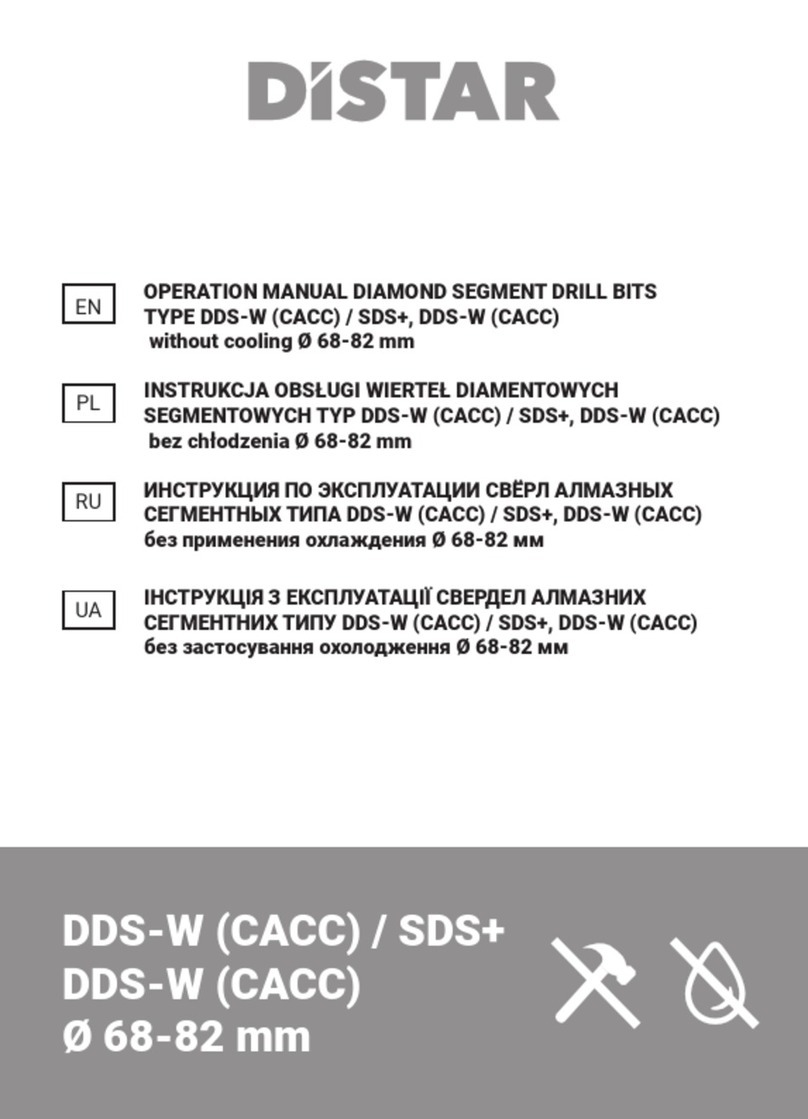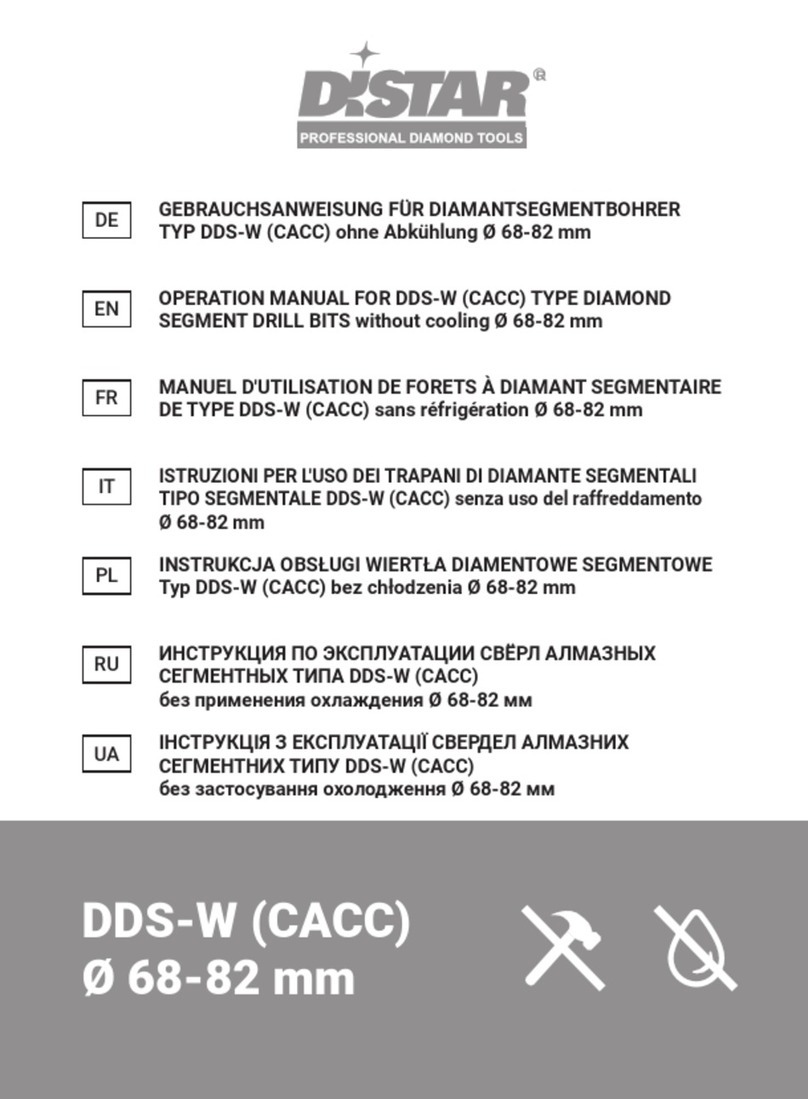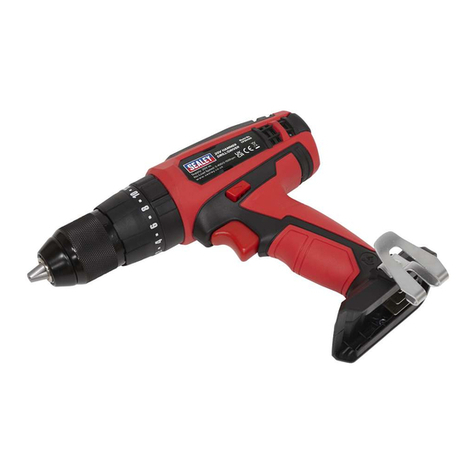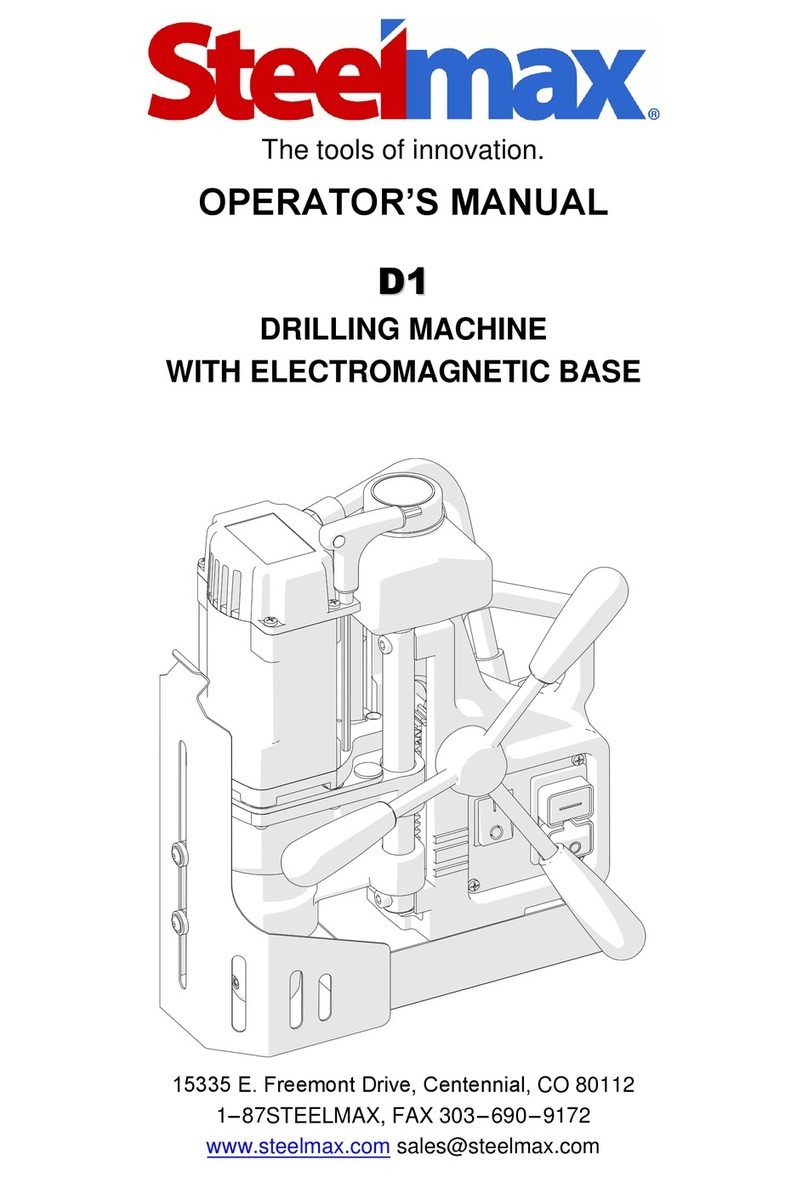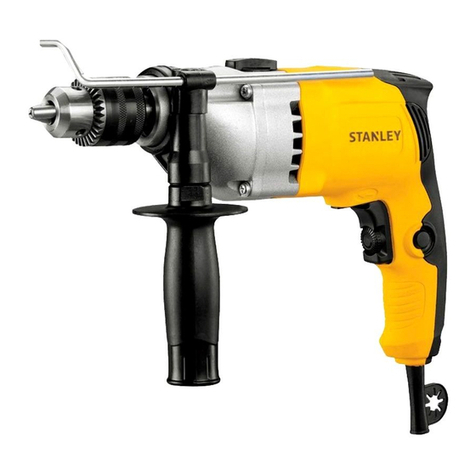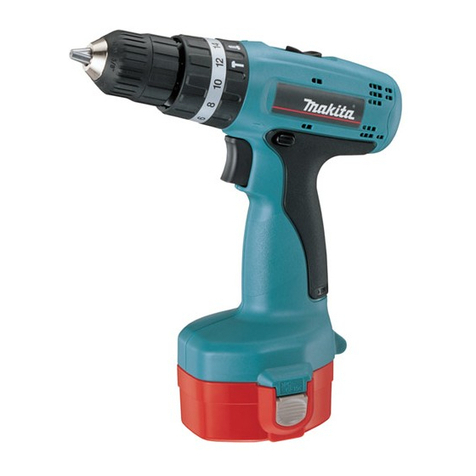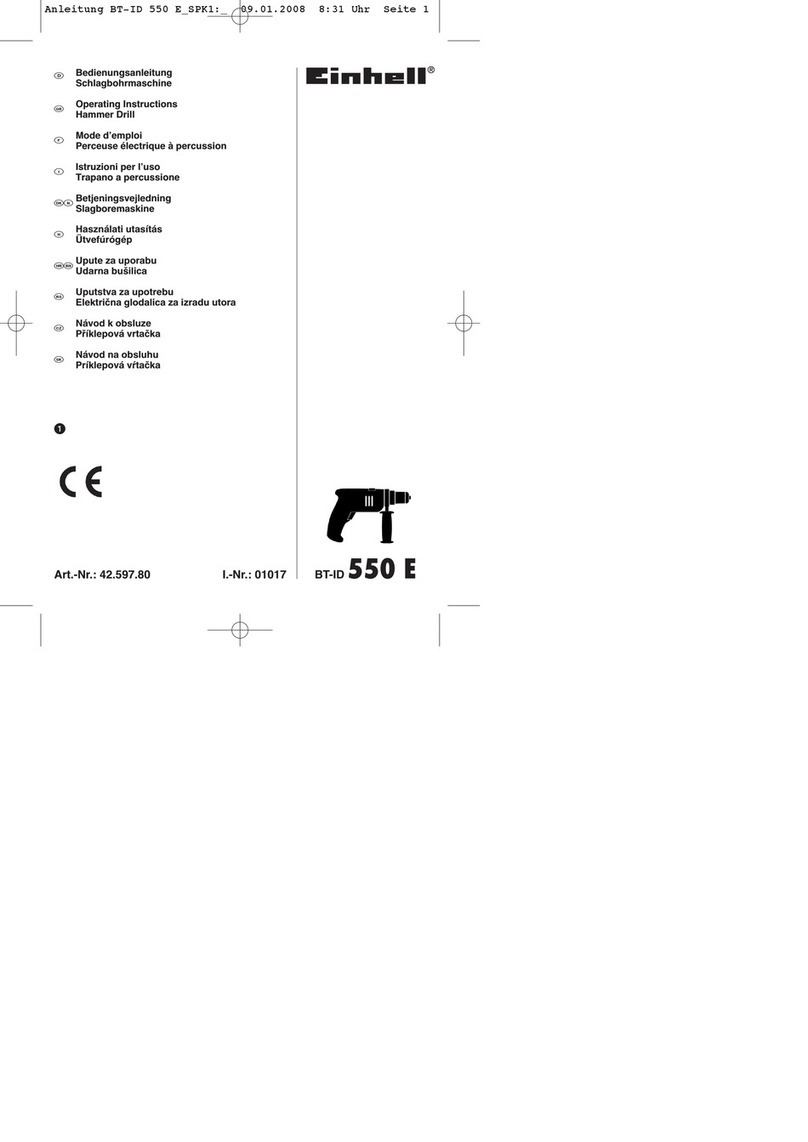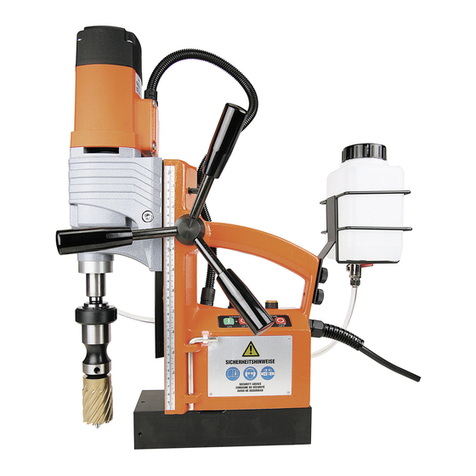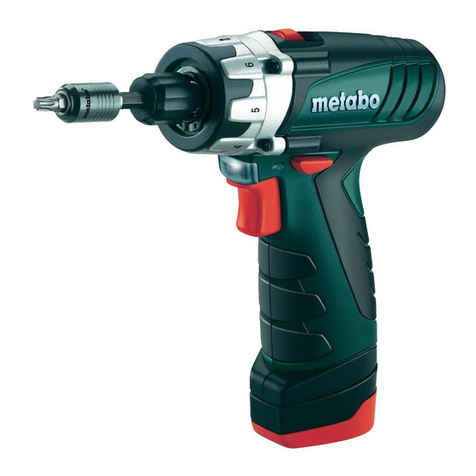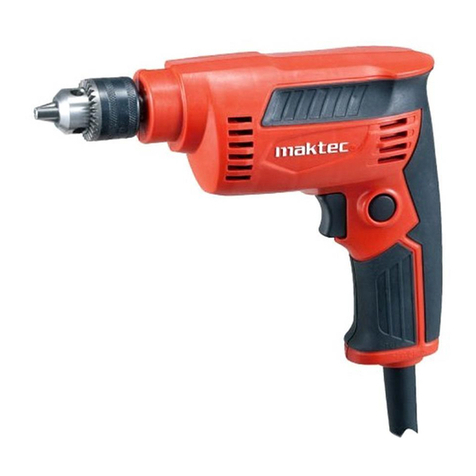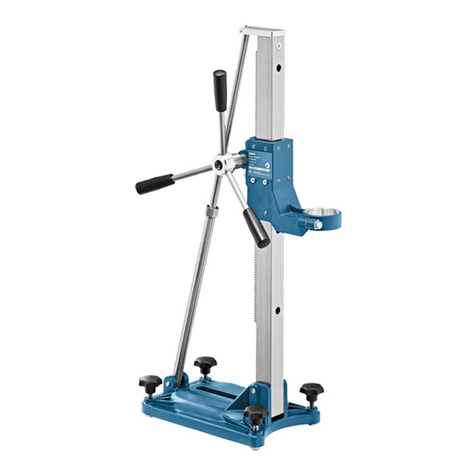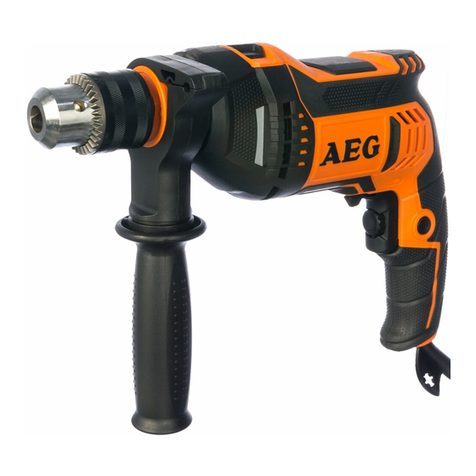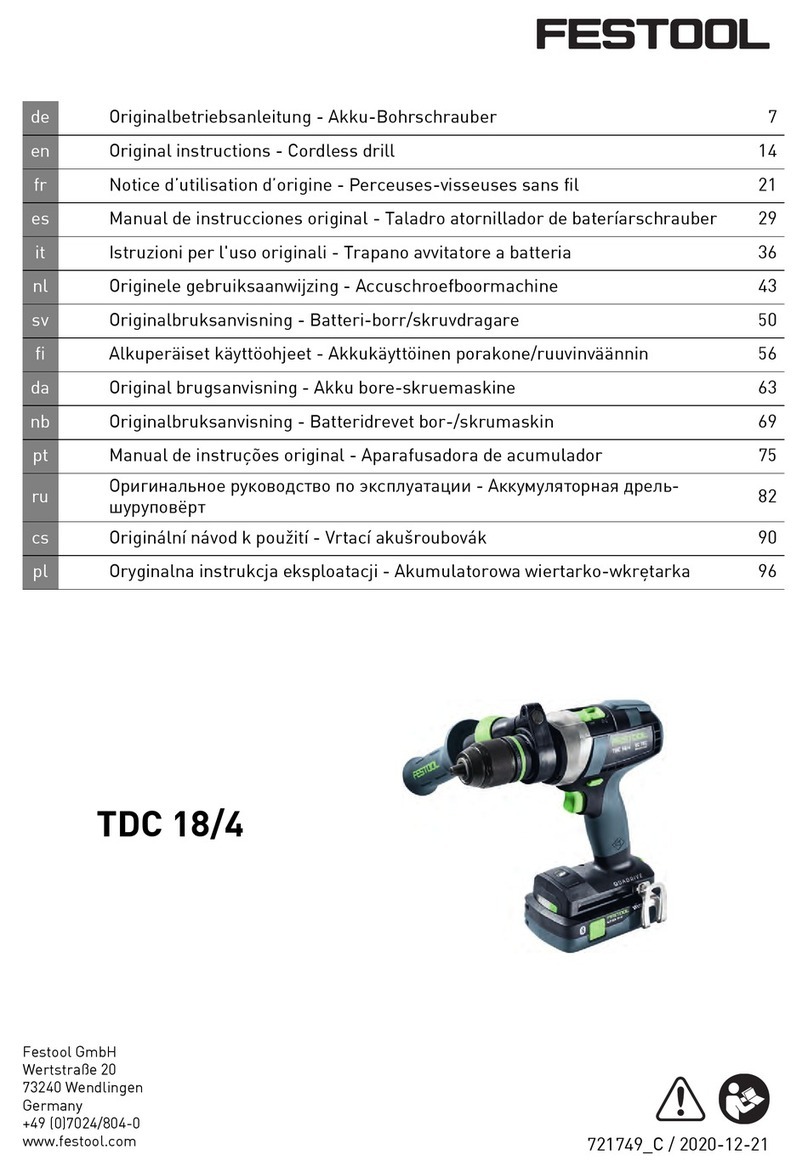Distar DDR User manual

DDR, DDS
(САМК, САМС)
L 50-80 mm
Bedienungsanweisung der Diamantbohrer; typ DDR, DDS L=50-
80 mm (САМК, САМС L=50-80 mm) mit der Verwendung der
Kühlung
Instrukcja obsługi wierteł diamentowych typu DDR, DDS L=50-80
mm (САМК, САМС L=50-80 mm) z chłodzeniem
Operation manual of DDR, DDS types diamond drill bits, L=50-80
mm (САМК, САМС L=50-80 mm) with cooling
Інструкція з експлуатації свердл алмазних сегментних
типа DDR, DDS, L=50-80 mm (САМК, САМС, L=50-80 mm)
із застосуванням охолодження
Інструкція з експлуатації свердл алмазних сегментних
типа DDR, DDS, L=50-80 mm (САМК, САМС, L=50-80 mm)
із застосуванням охолодження
DE
RU
PL
EN
UA


Hersteller/ Producer/ Producent/ Производитель/ Виробник
Hersteller: Di-Star GmbH, Ukraine
Poltava, Straße M. Biryuzova, 45А.
Tel.: +38 (0532) 508 720, 508 721
Producer: Di-Star Ltd, Ukraine,
M. Biruzov str., 45А, Poltava, Ukraine, 36007.
Tel.: +38 (0532) 508 720, 508 721
Producent: Di-Star Sp. z. o. o.
45A, ul. M.Biruzowa, Połtawa, Ukraina
Tel.: +38 (0532) 508-784, 508-720, 508-721
Importer: Di-Star.eu Sp. z. o. o.
ul. Grunwaldska 70H, 36-020 Tyczyn, Rzeszow, Poland
+48795656787 e-mail: sales@di-star.eu
NIP 813 383 41 16
Производитель: ООО «Ди-Стар» Украина,
г. Полтава, ул. М. Бирюзова, 45А.
Тел.: +38 (0532) 508 720, 508 721
Поставщик в России: ООО "Ди-Стар Центр"
Россия, г. Белгород, ул. Промышленная, 17а
тел.: +7 4722 357-353, факс: +7 4722 359-529
Виробник: ТОВ «Ді-Стар» Україна,
м. Полтава, вул. М. Бірюзова, 45А.
Тел.: +38 (0532) 508 720, 508 721, факс +38 (0532) 508 202.
Постачальник в Україні: ТОВ «Ді-Стар Трейд»
Україна, м Київ, вул. Чорноморська, 1, оф. 17, 3 пов.
телефон: +38 (050) 356-78-26; +38 (098) 007-45-40
DE
EN
PL
RU
UA

anwendbar
applicable
zastosowanie
применим
застосовується
bestmöglich anwendbar
optimally applicable
optymalne zastosowanie
оптимально применим
оптимально застосовується
Tabelle 1.
Eine Einsatzmöglichkeit des
Diamantwerkzeuges entsprechend
den Materialien:
Table 1.
Usage of diamond tool, depending
on materials:
Tabela 1.
Zastosowanie osprzętu
diamentowego wg materiałów:
Таблица 1.
Применяемость алмазного
инструмента по материалам:
Таблиця 1.
Застосування алмазного
інструменту за матеріалами:
Abriebfähigkeit / Abrasiveness/ ścieralność/
абразивность/ абразивність
5 10 15 20 25 30 35 40 45 50 55 60 65 70 75 80 85 90 95 100
5D
DDR, DDS (САМК, САМС)
D12 Granite Active • ••• ••• •• ••• ••• • • •
DDR, DDS (САМК, САМС)
M14 Granite ••• ••• ••• • • •
••• ••

anwendbar in seltenen Fällen
applicable in rare cases
zastosowanie w rzadkich przypadkach
применим в редких случаях
застосовується в рідкісних випадках
Abriebfähigkeit / Abrasiveness/ ścieralność/
абразивность/ абразивність
5 10 15 20 25 30 35 40 45 50 55 60 65 70 75 80 85 90 95 100
5D
DDR, DDS (САМК, САМС)
D12 Granite Active • ••• ••• •• ••• ••• • • •
DDR, DDS (САМК, САМС)
M14 Granite ••• ••• ••• • • •
•nicht anwendbar
not applicable
nie stosuje się
не применим
не застосовується

Tabelle 2.
Abriebfähigkeit der Materialien:
Table 2.
Abrasiveness of materials:
Tabela 2.
Ścieralność materiałów:
5 10 15 20 25 30 35 40 45 50 55 60 65 70 75 80 85 90 95 100
DE
Achat,
jasper,
onyx,
saphir
Glasierte
Fliese,
Glas
Weicher
Marmor,
Hartkalk-
stein
Hart-
marmor,
dolomit,
travertin
Hart-
keramik,
Feinstein-
zeug
Harte und
mittel-
harte
Granite,
Feinstein-
zeug
Weiche
Granite,
Gabbro,
Lab-
radorit,
Basalt
Hochar-
miertes
Beton,
Wasser-
baubeton
Fein-
beton,
Bürger-
steigplat-
ten
Beton,
armierter
Beton
Harter
Vollziegel,
Klinker-
zieger
Unbe-
wehrter
Beton,
Beton-
rohre
Hartsand-
stein,
Vormau-
erziegel
Tonplatte,
feuerfeste
Schleif-
baustoffe
Zement-
Sand-
dach-
stein,
Schamot-
teziegel
Sand-
stein-
ziegel,
Kalkstein
Schleif-
sandstein,
Schwemm-
stein
Muschel-
kries,
Zement-
Sand-
Estrich
Frischbe-
ton Asphalt DE
EN
Agate,
jasper,
onyx,
sapphire
Glazed
ceramic
tiles,
glass
Soft
marble,
hard lime-
stone
Hard
marble,
dolomite,
travertine
Hard
ceramic,
ceramic
granite
Hard and
medi-
um-hard
granites,
quartz-
ites
Soft
granites,
gabbro,
labra-
dorite,
basalt
Highly-re-
inforced
and
hydraulic
concrete
Fine-
grained
concrete,
paving
slabs
Concrete,
reinforced
concrete
Masonry,
clinkers
Non-re-
inforced
concrete,
concrete
pipes
Hard
sand-
stone,
facing
bricks
Ceramic
tiles,
refractory
abrasives
Cement-
sand
tiles,
reclay
bricks
Silicate
bricks,
lime-
stone
Abrasive
sand-
stone, tuff
Shell
lime-
stone,
sand-ce-
ment
screed
Green
concrete Asphalt EN
FR
Agate,
jaspe,
onyx,
saphir
Carreau
en céra-
mique
verni,
glace
Marbre
mou,
calcaire
dur
Marbre
dur, dolo-
mite,
travertin
Céra-
mique
dure, grès
cérame
Granits
durs et
moyens,
quartzites
Granits
mous,
gabbro,
labra-
dorite,
basalte
Béton
haut-ar-
mé,
béron hyr-
dotech-
nique
Béton
à grins
ns,
dalles de
trottoir
Béton,
béton
armé
Brique
dure
pleine,
clinker
Béton
non-ar-
mé,
tubes à
béton
Grès dur,
brique de
revête-
ment
Tuile cé-
ramique,
matériels
réfrac-
taires
abrasifs
Tuile de
ciment
et de
sable,
brique de
chamotte
Brique
silico-
calcaire,
calcaire
Grès
abrasif,
tuf
Roche co-
quillière,
serrage
de ciment
et de
sable
Béton
frais Asphalte FR
IT
Agata,
diaspro,
onice,
zaro
Piastrella
ceramica
smaltata,
vetro
Marmo
soce,
calcare
solido
Marmo
solido,
dolomite,
travertine
Ceramica
solida,
ceramo-
granito
Graniti
duro e
medio,
quarziti
Graniti
soci,
gabbro,
labra-
dorite,
basalto
Cemento
armato
alto, cal-
cestruzzo
idrotec-
nico
Calce-
struzzo
a grani
piccoli,
lastre da
marcia-
piede
Calce-
struzzo,
calce-
struzzo
rinforzato
Mattone
pieno
solido,
clinker
Calce-
struzzo
non
rinforzato,
tubo in
calce-
struzzo
Arenaria
solida,
mattone
di rivesti-
mento
Tegole di
ceramica,
refrattari
abrasivi
Tegole di
cemento
e sabbia,
mattone
di cha-
motte
Mattoni
di silicato,
calcare
Arenaria
abrasiva,
tufo
Calcare
fossi-
lifero,
massetto
di calce-
struzzo e
sabbia
Calce-
struzzo
fresco
Asfalto IT
PL
Agat,
jaspis,
onyks,
szar
Polewana
płytka ce-
ramiczna,
szkło
Marmur
miękki,
wapniak
twardy
Marmur
twardy,
dolomit,
trawertyn
Ceramika
twarda,
ceramo-
-granit
Granity
twarde
oraz
średnie,
kwarcyty
Granity
miękkie,
gabro,
labra-
doryt,
bazalt
Wysokoz-
brojony
żelbet,
hydro-
technicz-
ny beton
Drobno-
ziarnisty
beton,
płyta
chodni-
kowa
Beton,
żelbet
Cegła
pełna,
twarda,
klinkier
Beton
niezbro-
jony,
rury beto-
nowe
Piasko-
wiec
twardy,
cegła-li-
cówka
Dachówka
ceramicz-
na,
ogniotrwa-
łe opory
ścierne
Da-
chówka
cemento-
wo-
piaskowa,
cegła sza-
motowa
Cegła sy-
likatowa,
wapniak
Piasko-
wiec
ścierny,
trawertyn
Muszlo-
wiec,
jastrych
cemen-
towo-pia-
skowy
Beton
świeży Asfalt PL
RU
Агат,
яшма,
оникс,
сапфир
Глазуро-
ванная
керами-
ческая
плитка,
стекло
Мрамор
мягкий,
извест-
няк
твердый
Мрамор
твер-
дый,
доло-
мит,тра-
вертин
Твердая
керамика,
керамо-
гранит
Граниты
твер-
дые и
средние,
квар-
циты
Граниты
мягкие,
габбро,
лабра-
дорит,
базальт
Высоко-
армиро-
ванный
бетон,
гидротех-
нический
бетон
Мелко-
зерни-
стый
бетон,
троту-
арные
плиты
Бетон,
бетон
армиро-
ванный
Кирпич
полноте-
лый
твердый,
клинкер
Неар-
миро-
ванный
бетон,
бетон-
ные
трубы
Пес-
чаник
твердый,
кирпич
облицо-
вочный
Чере-
пица
керами-
ческая,
огнеу-
поры
абразив-
ные
Чере-
пица
цемент-
но-пес-
чаная,
шамот-
ный
кирпич
Кирпич
сили-
катный,
извест-
няк
Песча-
ник абра-
зивный,
туф
Раку-
шечник,
цемент-
но-
песчаная
стяжка
Свежий
бетон Асфальт RU
UA
Агат,
яшма,
онікс,
сапфір
Глазуро-
вана
кера-
мічна
плитка,
скло
Мармур
м’який,
твердий
вапняк
Мармур
твердий,
доломіт,
травер-
тин
Тверда
кера-
міка,
керамо-
граніт
Граніти
тверді і
середні,
кварцити
Граніти
м’які,
габро,
лабра-
дорит,
базальт
Висо-
коар-
мований
бетон,
гідротех-
нічний
бетон
Дріб-
нозер-
нистий
бетон,
тротуарні
плити
Бетон,
армо-
ваний
бетон
Цегла
пов-
нотіла
тверда,
клінкер
Неармо-
ваний
бетон,
бетонні
труби
Пісковик
твердий,
цегла
облицю-
вальна
Черепи-
ця кера-
мічна,
вогне-
триви
абра-
зивні
Чере-
пиця
цемент-
но-пі-
щана,
шамотна
цегла
Цегла си-
лікатна,
вапняк
Пісковик
абразив-
ний, туф
Чере-
пашник,
цемент-
но-
піщана
стяжка
Свіжий
бетон Асфальт UA
5 10 15 20 25 30 35 40 45 50 55 60 65 70 75 80 85 90 95 100

5 10 15 20 25 30 35 40 45 50 55 60 65 70 75 80 85 90 95 100
DE
Achat,
jasper,
onyx,
saphir
Glasierte
Fliese,
Glas
Weicher
Marmor,
Hartkalk-
stein
Hart-
marmor,
dolomit,
travertin
Hart-
keramik,
Feinstein-
zeug
Harte und
mittel-
harte
Granite,
Feinstein-
zeug
Weiche
Granite,
Gabbro,
Lab-
radorit,
Basalt
Hochar-
miertes
Beton,
Wasser-
baubeton
Fein-
beton,
Bürger-
steigplat-
ten
Beton,
armierter
Beton
Harter
Vollziegel,
Klinker-
zieger
Unbe-
wehrter
Beton,
Beton-
rohre
Hartsand-
stein,
Vormau-
erziegel
Tonplatte,
feuerfeste
Schleif-
baustoffe
Zement-
Sand-
dach-
stein,
Schamot-
teziegel
Sand-
stein-
ziegel,
Kalkstein
Schleif-
sandstein,
Schwemm-
stein
Muschel-
kries,
Zement-
Sand-
Estrich
Frischbe-
ton Asphalt DE
EN
Agate,
jasper,
onyx,
sapphire
Glazed
ceramic
tiles,
glass
Soft
marble,
hard lime-
stone
Hard
marble,
dolomite,
travertine
Hard
ceramic,
ceramic
granite
Hard and
medi-
um-hard
granites,
quartz-
ites
Soft
granites,
gabbro,
labra-
dorite,
basalt
Highly-re-
inforced
and
hydraulic
concrete
Fine-
grained
concrete,
paving
slabs
Concrete,
reinforced
concrete
Masonry,
clinkers
Non-re-
inforced
concrete,
concrete
pipes
Hard
sand-
stone,
facing
bricks
Ceramic
tiles,
refractory
abrasives
Cement-
sand
tiles,
reclay
bricks
Silicate
bricks,
lime-
stone
Abrasive
sand-
stone, tuff
Shell
lime-
stone,
sand-ce-
ment
screed
Green
concrete Asphalt EN
FR
Agate,
jaspe,
onyx,
saphir
Carreau
en céra-
mique
verni,
glace
Marbre
mou,
calcaire
dur
Marbre
dur, dolo-
mite,
travertin
Céra-
mique
dure, grès
cérame
Granits
durs et
moyens,
quartzites
Granits
mous,
gabbro,
labra-
dorite,
basalte
Béton
haut-ar-
mé,
béron hyr-
dotech-
nique
Béton
à grins
ns,
dalles de
trottoir
Béton,
béton
armé
Brique
dure
pleine,
clinker
Béton
non-ar-
mé,
tubes à
béton
Grès dur,
brique de
revête-
ment
Tuile cé-
ramique,
matériels
réfrac-
taires
abrasifs
Tuile de
ciment
et de
sable,
brique de
chamotte
Brique
silico-
calcaire,
calcaire
Grès
abrasif,
tuf
Roche co-
quillière,
serrage
de ciment
et de
sable
Béton
frais Asphalte FR
IT
Agata,
diaspro,
onice,
zaro
Piastrella
ceramica
smaltata,
vetro
Marmo
soce,
calcare
solido
Marmo
solido,
dolomite,
travertine
Ceramica
solida,
ceramo-
granito
Graniti
duro e
medio,
quarziti
Graniti
soci,
gabbro,
labra-
dorite,
basalto
Cemento
armato
alto, cal-
cestruzzo
idrotec-
nico
Calce-
struzzo
a grani
piccoli,
lastre da
marcia-
piede
Calce-
struzzo,
calce-
struzzo
rinforzato
Mattone
pieno
solido,
clinker
Calce-
struzzo
non
rinforzato,
tubo in
calce-
struzzo
Arenaria
solida,
mattone
di rivesti-
mento
Tegole di
ceramica,
refrattari
abrasivi
Tegole di
cemento
e sabbia,
mattone
di cha-
motte
Mattoni
di silicato,
calcare
Arenaria
abrasiva,
tufo
Calcare
fossi-
lifero,
massetto
di calce-
struzzo e
sabbia
Calce-
struzzo
fresco
Asfalto IT
PL
Agat,
jaspis,
onyks,
szar
Polewana
płytka ce-
ramiczna,
szkło
Marmur
miękki,
wapniak
twardy
Marmur
twardy,
dolomit,
trawertyn
Ceramika
twarda,
ceramo-
-granit
Granity
twarde
oraz
średnie,
kwarcyty
Granity
miękkie,
gabro,
labra-
doryt,
bazalt
Wysokoz-
brojony
żelbet,
hydro-
technicz-
ny beton
Drobno-
ziarnisty
beton,
płyta
chodni-
kowa
Beton,
żelbet
Cegła
pełna,
twarda,
klinkier
Beton
niezbro-
jony,
rury beto-
nowe
Piasko-
wiec
twardy,
cegła-li-
cówka
Dachówka
ceramicz-
na,
ogniotrwa-
łe opory
ścierne
Da-
chówka
cemento-
wo-
piaskowa,
cegła sza-
motowa
Cegła sy-
likatowa,
wapniak
Piasko-
wiec
ścierny,
trawertyn
Muszlo-
wiec,
jastrych
cemen-
towo-pia-
skowy
Beton
świeży Asfalt PL
RU
Агат,
яшма,
оникс,
сапфир
Глазуро-
ванная
керами-
ческая
плитка,
стекло
Мрамор
мягкий,
извест-
няк
твердый
Мрамор
твер-
дый,
доло-
мит,тра-
вертин
Твердая
керамика,
керамо-
гранит
Граниты
твер-
дые и
средние,
квар-
циты
Граниты
мягкие,
габбро,
лабра-
дорит,
базальт
Высоко-
армиро-
ванный
бетон,
гидротех-
нический
бетон
Мелко-
зерни-
стый
бетон,
троту-
арные
плиты
Бетон,
бетон
армиро-
ванный
Кирпич
полноте-
лый
твердый,
клинкер
Неар-
миро-
ванный
бетон,
бетон-
ные
трубы
Пес-
чаник
твердый,
кирпич
облицо-
вочный
Чере-
пица
керами-
ческая,
огнеу-
поры
абразив-
ные
Чере-
пица
цемент-
но-пес-
чаная,
шамот-
ный
кирпич
Кирпич
сили-
катный,
извест-
няк
Песча-
ник абра-
зивный,
туф
Раку-
шечник,
цемент-
но-
песчаная
стяжка
Свежий
бетон Асфальт RU
UA
Агат,
яшма,
онікс,
сапфір
Глазуро-
вана
кера-
мічна
плитка,
скло
Мармур
м’який,
твердий
вапняк
Мармур
твердий,
доломіт,
травер-
тин
Тверда
кера-
міка,
керамо-
граніт
Граніти
тверді і
середні,
кварцити
Граніти
м’які,
габро,
лабра-
дорит,
базальт
Висо-
коар-
мований
бетон,
гідротех-
нічний
бетон
Дріб-
нозер-
нистий
бетон,
тротуарні
плити
Бетон,
армо-
ваний
бетон
Цегла
пов-
нотіла
тверда,
клінкер
Неармо-
ваний
бетон,
бетонні
труби
Пісковик
твердий,
цегла
облицю-
вальна
Черепи-
ця кера-
мічна,
вогне-
триви
абра-
зивні
Чере-
пиця
цемент-
но-пі-
щана,
шамотна
цегла
Цегла си-
лікатна,
вапняк
Пісковик
абразив-
ний, туф
Чере-
пашник,
цемент-
но-
піщана
стяжка
Свіжий
бетон Асфальт UA
5 10 15 20 25 30 35 40 45 50 55 60 65 70 75 80 85 90 95 100
Таблица 2.
Абразивность материалов:
Таблиця 2.
Абразивність матеріалів:

BEDIENUNGSANWEISUNG DER DIAMANTBOHRER; TYP DDR, DDS
L=50-80 MM (САМК, САМС L=50-80 MM) MIT DER VERWENDUNG
DER KÜHLUNG
SEHR GEEHRTER KUNDE!
Wir bedanken uns bei Ihnen für die Produktwahl der Firma DI-STAR! Hohe Qualität
der Roh- und Werkstoffe, richtige Auswahl der Komponenten, Verwendung der modernen
Technologien sowie strenge Kontrolle machen unser Produkt würdig, um es innerhalb der
langen Frist zu verwenden.
Wir möchten Sie darum bitten, die Empfehlungen einzuhalten, die Sie in dieser Bro-
schüre nden, um alles nachstehend aufgeführte zu gewährleisten. Nur so können Sie die
Qualität Ihres Diamantwerkzeuges unterstützen DI-STAR.
AUFTEILUNG DES WERKZEUGES
DE
Das professionelle Diam-
antwerkzeug mit gutem
Verhältnis "Preis-Res-
source-Leistungsfähig-
keit". Eine Baureihe des
Vielzweckeinsatzes für
professionelle Arbeitsaus-
führung, grundsätzlich im
Haushaltsbereich.
Das professionelle
Diamantwerkzeug mit
dem besten Verhältnis
"Ressource-Leistungsfä-
higkeit-Einzelkosten für die
Bearbeitung". Die Baureihe
ist für große Umfänge
des Diamantschneidens
durch die Fachbenutzer
entwickelt.
Das professionelle Diamant-
werkzeug der Top-Klasse,
das den höchsten
Ansprüchen entspricht. Die
anwendungsspezische
professionelle Baureihe, die
auf die Bedürfnisbefriedi-
gung des Industriemarktes
gerichtet ist.
VERWENDUNGSZWECK
Die Diamantbohrer, Typ DDR, DDS L=50-80 mm (САМК, САМС L=50-80 mm), sind für
das Bohren der künstlichen und natürlichen Baustoffe mit Hilfe des Elektrohandwerkzeuges
mit der obligatorischen Verwendung der Kühlung (s. Tabelle 2, «Abriebfähigkeit der Stoffe»)
vorgesehen.
Die Bohrer, Typ DDR, DDS L=50-80 mm (САМК, САМС L=50-80 mm) werden mit sol-
chen Bauarten der Passbefestigung (für die Arbeit mit der Ausrüstung) hergestellt:
1) mit dem Schaft d12 für das Bohren mit Hilfe der Freihanddrehbohrmaschinen mit
der Leistung 0,8-1,5 KW, mit 800-1500 Umdrehungen pro Minute, bei der Betriebsart des
stoßfreien Bohrens;

2) mit dem inneren Gewindepassbohrer M14 für das Bohren mit Hilfe von Handwin-
kelschleifmaschinen mit der Leistung 0,8-1,5 KW, mit 2800-4000 Umdrehungen pro Minute.
Die Diamantbohrer, Typ DDR, DDS L=50-80 mm (САМК, САМС L=50-80 mm), gehören
nicht zum Sortimentverzeichnis, das zertizierungspichtig im Territorium der Ukraine ist.
Die Bohrer, Typ DDR, DDS L=50-80 mm (САМК, САМС L=50-80 mm), werden entspre-
chend den Technischen Vorschriften U 28.6-21078963-006:2005 hergestellt. Die Baugröße
und die Ausführung sind auf dem Gehäuse und auf der Verpackung des Produktes ange-
geben.
WARNUNG:
Lesen Sie bitte diese Anweisung aufmerksam durch, bevor Sie die Arbeit anfangen.
Die technischen Sicherheitsvorschriften sind bei der Verwendung des Diamantbohrers
und der von Ihnen zu verwendenden Ausrüstung streng zu beachten;
Vor dem Anfang der Ausführung jeglicher Arbeiten (Verschieben, Ersatz des Werk-
zeuges u. a.) mit den elektrischen Antriebsmaschinen ist der Dosenstecker aus der Netz-
steckdose herauszuziehen oder, dementsprechend, der Stromspeicher aus dem Gerät he-
rauszuholen.
Führen Sie die Standsichtkontrolle auf dem Fehlen der möglichen Beschädigungen
des Diamantwerkzeug vor jeder Verwendung durch.
Verwenden Sie nie das beschädigte Diamantwerkzeug.
Beschädigte, unsachgemäß festgesetzte oder unrecht verwendete Diamantwerkzeu-
ge können beim Verwenden außerordentlich gefährlich sein!
Leisten Sie die Arbeit in der Schutzbrille mit dem Seitenschild (mit Gesamtschutzmas-
ke), Atemschutzmaske, Kopfhörer und Handschuhen. Verwenden Sie immer die Sicherheits-
schuhe (verwenden Sie die Schürze, wenn erforderlich).
Der Werkstoff muss fest verankert sein.
Die Arbeit ohne Sicherheitsanlage des Geräts ist verboten (sehen Sie die Bedienungs-
anweisung des Produktherstellers)!
Es ist verboten, an der Diamantschichtanke zu arbeiten (für Schleifoperationen zu
verwenden);
Achtung! Gebrauch der Bohrer des DDR-, DDS-Typs L=50-80 mm (САМК, САМС
L=50-80 mm) im Wege des Schlagbohrens IST VERBOTEN!

Tabelle 3.
Die empfohlenen Betriebsweisen des Bohrens:
EMPFEHLUNGEN ZUR VERWENDUNG:
Sorgen Sie dafür, dass von Ihnen gekauftes Diamantwerkzeug für Verarbeitung des
ausgewählten Materials geeignet ist. Beachten Sie die Materialhinweise, die in diesem Hand-
buch vorgegeben sind (siehe Tabelle 1, 2, "Abrasivität der Materialien").
Der Außendurchmesser und Sitzhalter des Diamantwerkzeuges sollen die Charakte-
ristiken Ihres Geräts entsprechen.
ORDNUNGSGEMÄSSE MONTAGE:
Prüfen Sie vor der Installation des Bohrers seinen Sitzhalter auf Nichtvorliegen der
Anbrüche, Eindrücke oder anderer Beschädigungen, reinigen Sie ihn je nach Bedarf von der
Verschmutzungen und Staub.
Das Diamantwerkzeug muss einwandfrei installiert sein.
Bekommen Sie die Gewissheit über Nichtvorliegen des Spiels des Spindelaggregats
des Geräts, Anwesenheit eines spezielleren Adapters für die Kühlmittelzuführung im Bohrer
(nicht im Bohrersatz enthalten), sowie den Schließzustand der Backen am Spannfutter Ihres
Geräts. Alle drei Backen sollen sich beim Schließen auf gleicher Höhe benden. Der Bestand
des Spiels des Spindelaggregats des Geräts oder unrechtes Schließen der Futter-Backen
können zur Bildung des Radialschlags führen, was sich auf die negative Funktionsfähigkeit
des Bohrers auswirken kann, sowie zu seinem Brechen führen kann und dringend gefährlich
ist!
Installieren Sie den Bohrer an einem Gerät oder an einem speziellen Adapter (die Lie-
ferumfang des Bohrers enthält dies nicht), mit dem Kühlmittel in den Bohrer ießen kann.
Befestigen Sie den Bohrer mit den Schlüsseln, die mit dem elektrischen Betriebsmittel oder
standardmäßigen Gabelschlüsseln komplett sind (abhängig von der Befestigungsart für die
Bohr- oder Winkelschleifmaschine).
Verfahren
der
Passbe-
festigung
Bereich Ø,
mm
Emp-
fohlene
Umdre-
hungen
pro
Minute.
Emp-
fohlene
Antriebs-
leistung,
kW.
Maximale
Schneid-
tiefe,
mm.
Emp-
fohlener
Wasserbe-
darf,
l/min.
Förderart
des Kühl-
mittels
Emp-
fohlene
Ausrüs-
tung
D12 6-46 800-1500 0,8-1,5 20 mindes-
tens 0,6
wird von
der Seite
zulässig
Freihand-
drehbohr-
maschine
M14 6-35 2800-4000 0,8-1,5 25 mindes-
tens 0,4
ins
Innere des
Bohrers
Handwin-
kelschleif-
maschine

Erfüllen Sie einen Probelauf ohne Last während mindestens 30 Sekunden. Überzeugen
Sie sich von der Schwingungsfreiheit, vom Rundlauf- und Planlauffehler, von der Geräusch-
bildung während des Leerlaufes. Im Fall des großen Schlagfehlers lösen Sie das Futter mit
der Hilfe des Schlüssels, spreizen Sie die Backen auf den größten Durchmesser aus, dre-
hen Sie den Bohrer um 120 Grad um und wiederholen Sie die Vorgehensweise des Einbaus
des Bohrers. Beim Einbau des Bohrers auf die Handwinkelschleifmaschine wiederholen Sie
die Vorgehensweise des Einbaus des Bohrers. Im Wiederholungsfall der oben angeführten
Abweichungen führen Sie die Diagnostik Ihrer Ausrüstung oder des Diamantbohrers durch.
Achtung! Die Arbeit mit den Diamantbohrern, Typ DDR, DDS L=50-80 mm (САМК,
САМС L=50-80 mm) ist mit der kontinuierlichen Zuführung des Kühlmittels durchzuführen!
Verwenden Sie die Ausrüstung, die durch den Hersteller für die Arbeit mit dem Kühlmittel
und der Regelmöglichkeit der Umdrehungen!
ANWENDUNG:
Achtung! Vor dem Bohren stellen Sie Ihre elektrische Betriebsmittel in die Betriebs-
weise des stoßfreien Bohrens um!
Wichtig! Der Vorgang des Anbohrens und des weiteren Bohrens sind in der Betriebs-
weise des stoßlosen Bohrens (ohne Perforierung) durchzuführen! Die Nichterfüllung dieser
Anforderung kann zur Zerstörung des Bohrers führen und ist sehr gefährlich!
Der Kühlmittelverbrauch soll beim Bohren nicht kleiner als der, der in der Tabelle 3
angegeben ist, sein.
Wichtig! Das Kühlmittel soll kontinuierlich zugeführt werden. Die Nichterfüllung die-
ser Anforderung kann die Funktionsfähigkeit des Bohrers negativ beeinussen, zu seiner
Zerstörung führen und ist sehr gefährlich!
Förderarten des Kühlmittels:
1. Für die Bohrer mit der Passbefestigung D12 (das Bohren mit der Elektrohandbohr-
maschine) wird die Kühlmittelzuführung von der Seite in die Zone des Bohrens zulässig.
Dafür ist es möglich, einen Schlauch zu verwenden, der auf den Wasserleitungshahn aufge-
setzt wird, oder eine spezielle Flasche, in der der Druck mit der Handpumpe geschaffen wird
(gehört nicht zur Bestückung des Bohrers).
2. Für die Bohrer mit der Passbefestigung М14 (das Bohren mit der Handwinkel-
schleifmaschine) ist die Kühlmittelzuführung nur ins Innere des Bohrers auszuführen. Dafür
ist es notwendig, die spezielle Handwinkelschleifmaschine zu verwenden, wo die Kühlmittel-
zuführung durch die Welle oder mit der Hilfe des speziellen Adapters verwirklicht wird (die
Lieferumfang des Bohrers enthält dies nicht).
Die empfohlenen Umdrehungen der Welle des Spindelaggregats und die Antriebsleis-
tung der Ausrüstung sind in der Tabelle 3 "Die empfohlenen Betriebsweisen des Bohrens"
angegeben. Die Nichterfüllung dieser Empfehlung kann sich auf die Funktionsfähigkeit des
Bohrers negativ auswirken!

Für das Bohren wird es empfohlen, eine Formlehre-Bohrschablone zu verwenden (die
Lieferumfang des Bohrers enthält dies nicht), die zu dem Material mit den Schraubzwingen,
Saugnäpfen oder auf andere Weise, die ihre feste Haltung auf dem zu bearbeitenden Material
sicherstellt, befestigt wird. Das Bohren ohne Formlehre-Bohrschablone kann zur Zerstörung
des Diamantbohrers führen und ist sehr gefährlich!
Während der Arbeit des Diamantbohrers sind die Schwingungen oder die Stöße nicht
zulässig. Der Arbeitsvorschub ist leichtgängig, ruckfrei zu verwirklichen. Es ist notwendig,
die leichten Drehbewegungen (mit dem Rollen des Bohrers von der waagerechten Achse des
Bohrers auf 1-5 Grad, dies wird den zusätzlichen Ausgang des nassen Staubs von der Zone
des Bohrens sicherstellen) zu verwenden, um das Festklemmen zu vermeiden.
Während der Arbeit des Diamantwerkzeuges werden des Bohrstoßes, scharfe Vergrö-
ßerung der Tiefe des Bohrens nicht zulässig.
Lassen Sie keine Schrägstellung oder kein Festklemmen des Diamantwerkzeuges
während des Bohrens zu, dies kann zu seiner Zerstörung führen und ist sehr gefährlich!
Die Verwendung der übermäßigen Beanspruchung ist unzulässig. Die Nichterfüllung
dieser Anforderung kann die Funktionsfähigkeit des Bohrers negativ beeinussen, zu seiner
Zerstörung führen und ist sehr gefährlich!
Beim Ausgang des Bohrers minimalisieren Sie die Druckeinwirkung und den Rotati-
onswinkel des Bohrers.
Achtung! Halten Sie den Bohrer beim kompletten Durchbohren fest, damit kein Stoß
an die Anlageäche des zu bearbeitenden Materials passiert. Die Nichterfüllung dieser
Anforderung kann die Funktionsfähigkeit des Bohrers negativ beeinussen, zu seiner Zer-
störung führen und ist sehr gefährlich!
Die Betriebsdauer des Bohrers kann vom Grad der Abriebfähigkeit des zu bearbei-
tenden Materials abhängen. Je abrasiver das Material ist, desto weniger ist die Ressource
des Bohrers.
Nach der Erfüllung der Bohrung (oder beim möglichen Abbruch des Kerns innerhalb
des Gehäuses des Bohrers) entfernen Sie den Kern ordentlich mit der Hilfe des Stabes
durch die axialen oder durch die seitlichen Bohrungen.
Es ist notwendig, die Bohrer DDR, DDS L=50-80 mm (САМК, САМС L=50-80 mm)
abzunehmen und gesondert zu transportieren, um die Beschädigungen beim Transport der
Ausrüstung zu vermeiden. Es ist immer notwendig, den ordentlichen Transport der Bohrer
DDR, DDS L=50-80 mm (САМК, САМС L=50-80 mm) sicherzustellen und keine Fremdwir-
kungen auf die zuzulassen.

ANSCHLIFF:
Bei der Verminderung der Schneidfähigkeit des Bohrers (Abschleifen der Schneid-
lippen der Diamanten) wird es notwendig, die Diamantkörnungen auf der Arbeitsäche der
Segmente anzuschleifen. Dafür ist es notwendig, einige Bohrungen auf jedem abrasiven Ma-
terial, zum Beispiel, auf dem Backsteinbau zu erfüllen.
Die Häugkeit des nochmaligen Anschliffes der Diamantschicht hängt von der Härte
und dem Grad der Bearbeitungsfähigkeit des Materials ab.
Der zu häuge Anschliff kann zur Vermeidung der Betriebsdauer des Bohrers führen.
GARANTIEVERPFLICHTUNGEN:
Der Qualitätsanspruch bezüglich des erworbenen Diamantwerkzeuges wird auf der
Grundlage der ausgefüllten Reklamationsakte im amtlich vorgeschriebenen Vordruck und
des Vorhandenseins des Reklamationserzeugnisses akzeptiert.
Die Anspruchsprüfung wird durchgeführt:
a) wenn die Empfehlungen des Herstellerwerkes für den Betrieb des Werkzeuges nicht
beeinträchtigt wurden.
b) wenn der Verschleiß der Diamantschicht nicht mehr als 1/3 von ihrer Ausgangs-
höhe ausmacht.
Der Herstellerbetrieb trägt keine Garantieverpichtungen bezüglich der Leistungsfä-
higkeit des Werkzeuges, wenn der Käufer seine Konstruktion selbstständig geändert hat
(Eintragung der Änderungen in die Passbefestigung, Verwendung der selbstgemachten Ad-
apter (Verlängerungen), Bohren der zusätzlichen Bohrungen usw.).
Die Diamantbohrer sind mit der Diamantsegmentschicht auf der Metallbindung her-
gestellt.
Die Diamantschicht ist auf dem Stahlgehäuse befestigt, enthält keine Schadstoffe.
Die Nutzungsdauer ist nicht begrenzt. Es ist bei der Temperatur von -50°C bis zu +50°C
und der relativen Luftfeuchtigkeit bis zu 80% zu bewahren.

OPERATION MANUAL OF DDR, DDS TYPES DIAMOND DRILL BITS,
L=50-80 MM (DIAMOND ANNULAR DRILL BITS (САМК), DIAMOND
SEGMENTED DRILL BITS (САМС), L=50-80 MM) WITH COOLING
DEAR CUSTOMER!
Thank you for choosing products of DI-STAR company! The high quality of raw ma-
terials and other materials, the correct choice of components, the use of modern tech-
nologies, as well as precise control make our product worthy of using it for a long time.
To guarantee all of the following, please follow the recommendations found in this
brochure. This is the only way you can maintain the quality of your DI-STAR company di-
amond tools.
TOOLS CLASSIFICATION
EN
It's the professional
diamond tools with a good
combination of price -
resource - performance. A
series of universal use for
professional work, mainly
household area.
Professional diamond tools
with the best combination
of resource - productivity -
specic processing costs.
The series is designed for
large volumes of diamond
cutting by professional
users.
The TOP class professional
diamond tools that meet
the highest requirements.
Specialized professional
series aimed at meeting
the needs of the industrial
market.
PURPOSE OF USE
Diamond drill bits of the DDR, DDS type L=50-80 mm (САМК, САМС L=50-80 mm) are
designed for drilling articial and natural construction materials by a manual power tool with
the obligatory use of cooling (see Table 2, "Abrasiveness of materials").
Drill bits of the DDR, DDS type L=50-80 mm (САМК, САМС L=50-80 mm) are made
with following types of mounting (for the works on the equipment):
1) With shank drill d12 for manual electric drilling with a power of 0.8-1.5 kW with a
rotational speed of 800-1500 rpm in drilling shear mode;
2) With inner mounting M14 for drilling with the using of a manual angle grinder with
a power of 0.8-1.5 kW with a rotational speed of 2800-4000 rpm.

Diamond drill bits of DDR, DDS types, L=50-80 mm (DIAMOND ANNULAR DRILL BITS
(САМК), DIAMOND SEGMENTED DRILL BITS (САМС), L=50-80 mm) are not included in the
list of products subject to mandatory certication in the territory of Ukraine.
Drill bits of DDR, DDS TYPES, L=50-80 mm (DIAMOND ANNULAR DRILL BITS (САМК),
DIAMOND SEGMENTED DRILL BITS (САМС), L=50-80 mm) are produced in the accordance
with technical specications U 28.6-21078963-006:2005. The size and design are indicated
on the product body and packaging.
WARNING:
Please read carefully these Instructions before you start working.
Strictly follow the safety instructions for using the diamond drill bit and the tools you
use;
Before starting any work (moving, replacing tools, etc.) with electric drive machines,
remove the plug from the mains socket or, accordingly, remove the battery from the tools.
Before each use, make a visual check for possible damage to the diamond tool.
Never use a damaged diamond tool.
Damaged, improperly installed or incorrect used diamond instruments can be ex-
tremely dangerous when used!
You should perform your work in protective goggles with side protection (fully protect-
ed mask), respirator, headphones and gloves. You should always use protective footwear
(use an apron, if required).
The material to be processed must be properly secured.
It is prohibited to work without safeguard equipment (see the original operation man-
ual of the equipment manufacturer)!
It is prohibited to work with the lateral surface of the diamond layer (use for grinding
operations);
Attention! IT IS PROHIBITED to use drill bits of DDR, DDS TYPES, L=50-80 mm
(САМК, САМС L=50-80 mm) in striking drilling mode!
RECOMMENDATIONS FOR USE:
Make sure that the diamond tool, which you purchased, is intended for processing the
selected material. Pay attention to guidelines for material, contained in this manual (see.
Table 1, 2, "Abrasiveness of materials").
The outer diameter and landing mounting of a diamond tool shall be made to comply
with equipment characteristics.
APPROPRIATE ASSEMBLY:
Before installing the drill, you should check its landing mounting for the absence of
handling marks, dents or other damages, and if necessary, clear the drill from dirt and dust.
The diamond instrument must be perfectly installed.

Table 3.
Recommended drilling mode:
Make sure that there is no free play of tool-spindle unit of the equipment, special re-
ducing socket for coolant supply inwards of the drill (not included in the complete drill), and
the connecting condition of jaw members in the chuck of your equipment. When connected,
all three jaw members shall be at the same level. The presence of free play of the tool-spindle
unit of the equipment or the improper connection of the of jaw members in the chuck can
cause circular run-out, which can affect the negative working capacity of the drill, as well as
lead to its destruction, which is extremely dangerous!
Mount the drill on the equipment or on a special adapter (not included in the drill kit),
which allows the cooling liquid to be fed inside the drill. Secure the drill by using wrenches,
which are included in the electric equipment kit, or standard open wrenches (depending on
the type of drill mounting or for the manual angle grinder).
Perform a dry-run test without load for at least 30 seconds. Make sure that there are
no vibrations, circle run-out or butt beats, and any unwanted sounds when running without
load. In case of a large release beat, use the key to free the chuck, screw jaw members at the
maximum diameter, rotate the drill at 120 degrees and repeat the drill mounting procedure.
When mounting the drill on a manual angle grinder, repeat the drill mounting procedure. In
case of a repetition of the above-mentioned deviations, make a diagnostic of your equipment
or diamond drill.
Attention! Diamond drill bits of DDR, DDS types and L=50-80 mm (DIAMOND AN-
NULAR DRILL BITS (САМК), DIAMOND SEGMENTED DRILL BITS (САМС), L=50-80 mm)
must be operated with a continuous supply of liquid coolant! You should use the equip-
ment, which is authorized to work with liquid coolant and with the ability of rotation speed
regulation!
USE:
Attention! Turn your electrical equipment into an in drilling shear mode, before drilling!
Important! Stop drilling procedure and further drilling should be performed in the drill-
ing shear mode (without perforation)! Failure to comply with this requirement can lead to the
Landing
mounting
method
Range Ø,
mm
Recom-
mended
rotation,
rpm.
Recom-
mended
drive
power,
kW.
Maximum
depth of
cut, mm.
Recom-
mended
water
consump-
tion,
Practice
method
of liquid
coolant
Recom-
mended
tools
D12 6-46 800-1500 0,8-1,5 20 not less
than 0,6
allowed
from the
side
manual
electric
drill
M14 6-35 2800-4000 0,8-1,5 25 not less
than 0,4
inside the
drill
manual
angle
grinder

destruction of the drill, which is extremely dangerous!
The liquid coolant consumption rate at drilling shall be at least as specied in Table 3.
Important! Liquid coolant should be supplied continuously. Failure to comply with this
requirement can affect the negative working capacity of the drill and lead to the destruction
of the drill, which is extremely dangerous!
Practice method of liquid coolant:
1. For drills with D12 landing mounting (drilling with using an electric drill), it is con-
sidered acceptable the fed of liquid coolant from the third side to the drilling zone. For this
purpose, you can use a hose, which is mounted on a water tap or a special cylinder which is
pressurized by a hand pump (not included in the drill tting), which is mounted on a water tap
or a special cylinder which is pressurized by a hand pump (not included in the complete drill).
2. For drills with M14 landing mounting (drilling with using a manual angle grinder),
it is considered acceptable only the fed of liquid coolant inside drill. For this purpose, you
should use a special manual angle grinder, where the fed of liquid coolant is performed
through the shaft or with using a special adapter (which is not included in the complete drill).
The recommended rotation speed of the tool-spindle unit shaft and the power of the
drive of the equipment are given in Table 3, "Recommended drilling modes". Failure to comply
with this recommendation could have a negative impact on the working capacity of the drill!
For drilling, it is recommended to use a conductor template (not included in the com-
plete drill), which is connected to the material with claw anges, suction cups or other means
to ensure its strong retention on the material to be processed. Drilling without use of a con-
ductor template can lead to destruction of a diamond drill, which is extremely dangerous!
Vibration and strikes are prohibited during work of a diamond drill. The regular feed
shall be smooth and without any jerks. To avoid jamming, it is necessary to use light rotation-
al motions (by swinging the drill from the vertical axis of the drill by 1-5 degrees – this will
provide an additional discharge of wet dust from the drilling zone.
Strikes and sharp increases in the drilling depth are prohibited during the work of a
diamond tool.
Prevent twisting and jamming of diamond tool, it can lead to the destruction of dia-
mond tool, which is extremely dangerous!
Excessive loading is not allowed. Failure to comply with this requirement can affect
the negative working capacity of the drill and lead to the destruction of the drill, which is
extremely dangerous!
Minimize pressure and angle of rotation of the drill when exiting from the hole.
Attention! Hold down the drill during complete perforation to prevent impact on the
supporting surface of the material to be processed. Failure to comply with this requirement
can affect the negative working capacity of the drill and lead to the destruction of the drill,
which is extremely dangerous!

The service life of the drill may depend on the level of abrasiveness of the material
being processed. The more abrasive the material, the smaller the service life of the drill.
After completion of the hole (or if the drill core break inside the drill shell), carefully
remove the drill core with the using of a rod through the axial or lateral openings.
To avoid damage during transportation of DDR, DDS drills L=50-80 mm (САМК,
САМС L=50-80 mm) you should remove it and transport separately. You should always
ensure the safety transportation of DDR, DDS drills L=50-80 mm (САМК, САМС L=50-80
mm) and guard against external damages.
CUTTER GRINDING:
When drill cutting capacity is reduced (over-grinding of diamonds cutting edges) di-
amond grits must be sharpened on the working surface of the segments. To do this, you
should make several holes on any abrasive material, such as brickwork.
The frequency of repeat cutter grinding of the diamond layer depends on hardness
and processing level of material.
Very frequent cutter grinding can reduce the drill service life.
GUARANTEE:
The claim for the quality of the purchased diamond tool is accepted based on the
completed damage statement set form and the presence of the advertising product.
Consideration of the claim is executed in the following cases:
a) if the manufacturer’s recommendations for the operation of the tool have not been
violated.
b) if the wear and tear of the diamond layer shall not exceed 1/3 of its initial height.
The manufacturer shall not be bound by the performance warranty of the instrument
if the buyer changes the design (modication of landing mounting, using of self-made adapt-
ers (length extension piece), drilling additional holes etc.) by himself.
Diamond drills are produced with a segmented diamond layer on matrix metal.
The diamond layer is xed to a steel body and contains no harmful substances.
No expiration date. Store at the temperature from -50°С to +50°С and relative humidity
up to 80%.


INSTRUKCJA OBSŁUGI WIERTEŁ DIAMENTOWYCH TYPU DDR, DDS
L=50-80 MM (САМК, САМС L=50-80 MM) Z CHŁODZENIEM
DRODZY KUPUJĄCY!
Dziękujemy Państwu za wybór produktów rmy DI-STAR! Wysoka jakość surowców i
materiałów, właściwy dobór komponentów, zastosowanie nowoczesnych technologii oraz
precyzyjna kontrola sprawiają, że nasz produkt jest godny długotrwałego użytkowania.
W celu zagwarantowania wszystkich poniższych informacji, prosimy o przestrze-
ganie zaleceń zawartych w niniejszej broszurze. Tylko w ten sposób będziesz w stanie
utrzymywać jakość Twojego osprzętu diamentowego DI-STAR.
KLASYFIKACJA NARZĘDZI
PL
Profesjonalny osprzęt
diamentowy o dobrej
kombinacji cena-żywot-
ność-wydajność. Seria
uniwersalnego zastoso-
wania do profesjonalnego
wykonywania prac głównie
domowych.
Profesjonalny osprzęt
diamentowy z najlepszym
stosunkiem żywotność-
-wydajność-jednostkowe
koszty przetwarzania. Seria
została zaprojektowana
do cięcia diamentowego o
dużej objętości przez profe-
sjonalnych użytkowników.
Profesjonalny osprzęt
diamentowy TOP klasy,
spełniający najwyższe
wymagania. Wyspecja-
lizowana profesjonalna
seria mająca na celu
zaspokojenie potrzeb rynku
przemysłowego.
PRZEZNACZENIE
Wiertła diamentowe typu DDR, DDS L=50-80 mm (САМК, САМС L=50-80 mm) prze-
znaczone są do wiercenia sztucznych i naturalnych materiałów budowlanych za pomocą
ręcznego elektronarzędzia z obowiązkowym chłodzeniem (patrz Tabelę 2, „Ścieralność
materiałów”).
Wiertła typu DDR, DDS L = 50-80 mm (САМК, САМС L=50-80 mm) są produkowane z
następującymi rodzajami części mocującej (do pracy na sprzęcie):
1) z trzpieniem d12 do wiercenia za pomocą ręcznych wiertarek elektrycznych o mocy
0,8-1,5 kW, przy obrotach 800-1500 obr./min, w trybie wiercenia bez uderzenia;
This manual suits for next models
1
Table of contents
Languages:
Other Distar Drill manuals
